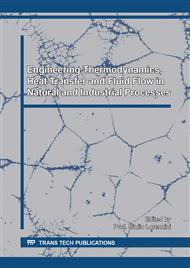[1]
Chiu-On Ng, Rudraiah N., Nagaraj C., and Nagaraj H.N., Electrohydrodynamic Dispersion of Macromolecular components In Nanostructured Biological Bearing. Journal of Energy, Heat and Mass Transfer. 27 (2005) 39 – 64.
Google Scholar
[2]
Taylor G.I., Dispersion of soluble matter in solvent flowing slowly through a tube, Proc. Roy. Soc., (Lond.). A 219 (1953) 186-203.
DOI: 10.1098/rspa.1953.0139
Google Scholar
[3]
Beavers G.S. & Joseph D.D., Boundary conditions at a naturally permeable wall. J. Fluid. Mech.30 (1967) 197-207.
DOI: 10.1017/s0022112067001375
Google Scholar
[4]
Aris R., On the Dispersion of a Solute in a Fluid Flowing Through a Tube. Proc. Roy. Soc. London. Series A, 235 (1956) 67.
Google Scholar
[5]
Sankarasubramanian R. and Gill W. N., Taylor diffusion in laminar flow in an eccentric annulus. Int. J. Heat and Mass Transfer. 14, 7 (1971) 905-919.
DOI: 10.1016/0017-9310(71)90117-7
Google Scholar
[6]
Feldman E.E., Hornbeck R.W., and Osterle J.F., A numerical solution of laminar developing flow in eccentric annular ducts. Int. J. of Heat and Mass Transfer. 25, 2 (1982) 231- 241.
DOI: 10.1016/0017-9310(82)90009-6
Google Scholar
[7]
Rudraiah N., Coupled parallel flow in a channel and a bounding porous medium of finite thickness. J. fluid Eng. 107 (1985) 322-329.
DOI: 10.1115/1.3242486
Google Scholar
[8]
Kalavathi G.K., Dinesh P.A., and K. Gururajan, Influence of Roughness on Porous Finite Journal Bearing with Heterogeneous slip/ no-slip surface. Tribology International. 102, (2016) 174-181.
DOI: 10.1016/j.triboint.2016.05.032
Google Scholar
[9]
Umadevi B., Dinesh P.A., Indira R and Vinay C.V., Mass transfer in an electric annular region through diffusion, MCB,Tech science press. 11, 2, (2014) 101-111.
Google Scholar
[10]
Sandeep N., Effect of aligned magnetic field on liquid thin film flow of magnetic-nanofluids embedded with graphene nanoparticles, Advanced Powder Technology (2016) http://dx.doi.org/10.1016/j.apt.2016.12.012.
DOI: 10.1016/j.apt.2016.12.012
Google Scholar
[11]
Ali M.E. and Sandeep N., Cattaneo-Christov model for radiative heat transfer of magnetohydrodynamic Casson-ferrofluid: A numerical study. Results in physics 7(2017)21-30.
DOI: 10.1016/j.rinp.2016.11.055
Google Scholar
[12]
Delecrin j., Oka M. Takahashi S., Yamamuro t., & Nakamura j.t., Changes in joints fluid after total arthoplasty, Clin. Orthop. 307 (1940) 240 – 249.
Google Scholar


